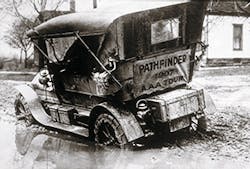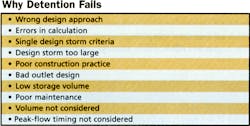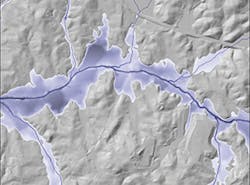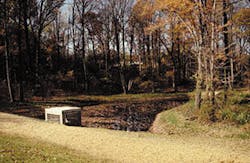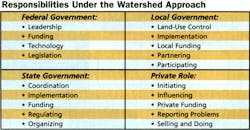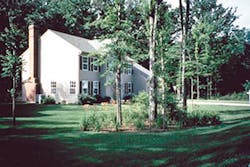A little learning is a dangerous thing;
Drink deep, or taste not the Pierian spring:
There shallow draughts intoxicate the brain,
And drinking largely sobers us again. –Alexander Pope
I once heard the story of a public meeting gone comical. The local public works engineer had just finished carefully explaining that a regional detention facility was to be constructed to handle the flooding within a certain watershed (“No, sir, no prisoners involved here—this is stormwater detention”) and that construction of this facility would also cost each resident a certain sum of money. Knowing him, I’m sure he was careful to fully explain the benefits and fairness of the allocation. Finally, after all was said and done, a woman in the back stood up and said, “Now Mr. Smith [names have been changed to protect the famous], this is all well and good, and I’m sure it is very necessary, but I just have one question: I want to know how I got in this watershed—and I want out!”
This woman needs a new stormwater paradigm. Not just because she is opposed to regional detention (maybe she’s right!), but because she does not know what she does not know.
That’s the definition of a paradigm. It’s what we think is true and right about a certain subject. It’s the grid through which we put all information and input about a subject. In fact, it’s everything we think is true about something. If we thought there were more to know, we would fit it into our paradigm somewhere. Whether our paradigm is, in fact, true and effective (somehow the word efficacious comes to mind) is not the point. We believe it is. And we only reluctantly change our ways and agree to agree with someone else’s paradigm. Stormwater management is full of cantankerous people with strongly held opinions. You don’t believe me? Is “stormwater” one word or two? I rest my case.
We each have paradigms about most everything…even stormwater. Since you are voluntarily reading this article (unless this is the only thing left in the dentist’s office), you are far beyond that woman’s level of stormwater knowledge. But do you know where you really are in the shifting paradigms of stormwater management? Let’s find out.
Early Stormwater Paradigms
The evolution of stormwater practice in the United States is set against the backdrop of social change. Since the 1800s, the basic thrust in the US has shifted from exploration to cultivation to industrialization to urbanization to gentrification. “Gentrification” is when we need a double vanilla decaf latte (“Hold the whipped cream”) instead of a cup of coffee, and we have the money to pay for it. It is when we want not only a safe and efficient neighborhood but also a “green” one with walking paths and natural areas.
Paradigm 1: Run It in Ditches
n the beginning, the rugged pioneers got tired of the horse commute and began to move to town. And what was good enough for the country was good enough for the city. This led to the first stormwater paradigm: Water should run in ditches, just like on the farm.
Everything—and I mean everything—flowed in urban cesspool ditches: slop, wash water, runoff, and chicken bones. This worked for a while and was better than having no drainage system at all. When ditches and culverts were sized at all, there were some interesting rules. Some early railroad openings were sized according to the time it took a horse rider to traverse the watershed perimeter. Sort of a human planimeter.
The drawbacks of this grand solution were soon apparent. Even Benjamin Franklin realized these ditches were an eyesore (not to mention a “nose sore”) and that women trying to cross them risked life and petticoat.
So engineers, ever the inventive public servants, came up with a solution to this dilemma, and unknowingly stepped into the second paradigm: “Let’s put it all in pipes.”
“Run It in pipes” goes downtown 5th Avenue
Paradigm 2: Run It in Pipes
The urban infrastructure underwent a rapid change around the turn of the century–the turn before this last one, I mean. Downtown areas became clean and dry. All liquid waste went straight from the amazing flush toilets and sinks to the nearest river or stream.
Just as World War I was called “The Great War” before the existence of World War II, combined sanitary and stormwater sewers were called “sewers” before the existence of separate sewers. Today we call them “combined sewer systems.” You can find planned combined sewers in the center of most older large cities and in unplanned ones everywhere.
Sewers solved the mire-in-the-street problem by putting it safely and efficiently in the streams. But soon plagues convinced cities to shift from well to surface water, as people realized that all this mire-in-the-streams was being ingested by downstream dwellers. It was determined that we needed treatment plants for sewage and that treating all that clean stormwater runoff did not make economic sense.
So dutiful engineers came up with a new paradigm and a solution to this dilemma: Run it in stormwater pipes.
“Now tell me, you got a college degree to do this good?”
Paradigm 3: Run It in Stormwater Pipes
This urban stormwater design paradigm became vogue about the time Johnny came marching home from Europe the second time, and it reigned until the 1970s or so. All Johnny wanted was a ranch-style home in the suburbs in a nice, clean, neat neighborhood. Leave It To Beaver and curb and gutter were de rigueur. It was not till a decade or two later, after a strong dose of cultural cynicism, that we thought much about “ticky tacky” and it not being right to all look just the same.
Technology always comes along to support our rush to engineering excellence. About this time the Rational Method came into prominence as the design method of choice, beating out several competitors. It was easy to do on a slide rule and made sense as a mass transfer equation. Intensity-duration-frequency curves became available in many places in the US in the late 1950s and everywhere in the early 1960s with the publication of the Weather Bureau’s TP40 and western mountain rainfall maps.
The modern urban drainage infrastructure was born, consisting of an efficient drainage system with catch basins and pipes leading to the nearest stream. And that solved the problem. Or did it? Anecdotal evidence began to mount. Papers began to appear questioning this paradigm. It soon became apparent to standard engineers that the fruit of an efficient stormwater system is downstream flooding and channel erosion. The literature from the 1970s is replete with papers on the causes of flooding and a groovy new idea to solve flooding forever: onsite detention.
Paradigm 4: Keep It From Stormwater Pipes
The first stormwater detention ordinances appeared in the early 1970s and quickly spread across the country. Everyone had one, and each thought his was the best. None of them worked very well.
Detention ponds are a promise with conditions. Rarely are those conditions adequately met in a local, onsite detention program. The conditions include comprehensive criteria, consideration of volume and peak, downstream assessment, realistic hydrograph routing, detailed plan review, as-built certification, long-term maintenance agreements, and strict enforcement.
Take, for example, the impacts of volume. After a football game lets out in Nashville, there is a traffic jam for hours in the vicinity of the stadium, and not just because of midgame beer consumption. Once three major events all let out within a half hour of each other. It was pandemonium for hours and for miles. Each parking lot let out only so many cars at once, like a detention pond. But hundreds of lots were all letting out cars at a controlled rate. The problem was a car volume problem, not a peak-flow problem.
This happens every time it rains. Each detention pond is similar to those parking lots, but for runoff. The rainfall “event” is generating three to five times more water all at once, everywhere. Directly below the detention pond the peak of runoff may be controlled. But downstream, maybe at the point where the total drainage area is 10 times the area detained, the stream cannot even tell that detention has taken place (anthropomorphically speaking). It’s a runoff volume problem, not a peak problem.
Let’s do another one. The Rational Method is exact for peak-flow estimation of a constant flow of water off of a pane of glass and OK for parking lots and rooftops with some grass and erratic rainfall. It’s not a good detention designer. Thousands of ponds were (are!) designed using the Modified Rational and Bowstring methods. Most are undersized, some grossly. Allowable target flows are set too high because the predevelopment C factors, conservative for peak flow, are sometimes nonconservative for setting low-flow target values. Volumes are set too low because the actual runoff hydrograph is not truncated like a simple triangle. Ten-year control does nothing for two-year downstream flooding problems.
Old people living along streams were still getting flooded and saying it was not like this in the 1960s. And they were right. We needed a new and better paradigm to solve this problem.
Technology making master plans effective
Paradigm 5: Well, Just Don’t Cause Flooding
I entered college with a slide rule and a large deck of computer-punched cards (“Uh, miss, don’t hold them with one hand or you’ll dro–aaaarrrrrg!”). I left college with a multifunction calculator and an awesome 8086 PC. The first mainframe hydraulics and hydrology models were converted for PC use in the mid- to late 1970s and became commonly available in the mid-1980s. MITCAT led the way. Every engineer worth his bonus developed a user-friendly HEC-1 front-end program, and a few got rich selling theirs to the rest of us. I now have more computing power under the palm of my hand than my whole university had when I was a freshman there. Good old technology.
With all this new computing power, the literature in the 1970s began to reflect a new concept: stormwater master planning. The idea was that I could construct a hydrology model (how much water how often?) and a hydraulics model (how fast and high does the water from the hydrology model go?) of a watershed and then do “what if” analysis until I found the perfect solution to flooding problems–current problems and those only imagined. It suddenly became too hard for local communities to do stormwater by themselves. But we consultants were glad to help out. The “regional treatment” mantra was everywhere mouthed by knowing experts. H&H jockeys appeared out of nowhere.
By 1985, hundreds of master plans had been developed, and one or two were actually built the way they were planned. This led to the coining of a new understanding of how the world really works, called the “Hydro-Illogical Cycle.” In this cycle, local governments proceed from flooding to panic to planning, and then to procrastination until the next flood. “˜Round and “˜round they go.
Many things conspire to cause chronic flooding. Only five of them are physical: more water than before, a clogged or broken system, a system designed too small in the first place, homes located in the wrong place, and an act of God–or someone more diabolical. All the rest of the reasons are institutional in nature. So it takes a lot more than a spiffy model and a Ph.D. to make a stormwater master plan a success. That’s the easy part. Many stormwater engineers hung up their PCs and learned consensus building, stormwater finance (stormwater utilities sprang up about this time), and public relations.
With these new skills, more and more flooding problems were solved on a neighborhood, if not on a watershed, basis. Some of us began to think we would need to become financial planners or life insurance salesmen in a few years when all the master plans were done and all the problems were solved once and for all time. Maybe even dot-com entrepreneurs.
We couldn’t have been more wrong.
The New Breed of Stormwater Paradigms
I think you’re beginning to see the pattern. University professors and other troublemakers begin to publish ideas about how to solve current problems. New paradigms emerge. Each stormwater paradigm solves the immediate problem of the past paradigm and creates a more insidious problem of its own. Thus, long-term employment is guaranteed.
Or, as we will shortly see, knowledge and technology create a real or perceived need for higher, more demanding levels of stormwater management—and regulation.
It’s not that the past paradigms disappear. They are alive and well in various parts of the country. In fact, it’s at this point in my standard lecture on stormwater paradigms that people start to fidget and look at the floor. Why? Because this or that paradigm is where they now live. And they suspect there are quite a few paradigm shifts ahead of them—and they are nowhere near career retirement!
Back to the story line. About this time, the first Section 208 areawide studies were just being completed. They contained learned discussion about combined sewer overflow problems, detailed evaluation of wastewater point-source controls and technology, expert industrial-pollution source and assessment strategies, and vague hand waving about stormwater runoff.
No one important was sure what to do about this mysterious source of pollution. Actually, no one was even sure just how much of a real problem stormwater runoff was. Opinions multiplied like fecal colonies on a warm summer day. And there was some similarity. Data were scarce, and reliable data were nonexistent. But everyone, in their heart of hearts, knew that urban streams are trashed—and runoff is an unindicted co-conspirator. EPA to the rescue.
Micropool extended detention
Paradigm 6: Oh, and Don’t Pollute Either
Just when you think you are seeing the light at the end of the stormwater tunnel, along comes the regulatory freight train: the Phase I stormwater regulations. As a result of the 1987 Water Quality Act, the 1986 publication of the National Urban Runoff Program final report, and 305(b) reports, stormwater runoff became public (works) enemy number one.I was “privileged” to be in an EPA support role at several of the initial public meetings around the country where Phase I was explained. I remember one in particular where a big Texas dude strode right past the mid-aisle microphone for questions and approached the podium. In response to an unfortunate definition of “waters-of-the-state,” he remarked, “Now let me get this straight: If it walks like a duck, quacks like a duck, and has feathers like a duck, from now on we’re all going to have to call it a PIG. Is that right?” As I recall, a few Washington lawyers left the program shortly thereafter.
Don’t get me wrong. My idea of a great day is to walk along a stream with my kids turning over rocks to see what’s there. But the stormwater-quality regulations hit some local governments like a two-by-four from the blind side. Einstein was right: Premature responsibility does breed superficiality. Many cities and counties spent large sums of money on untested structural best management practices (BMPs) and unworkable regulatory controls, trying to meet ill-defined standards of “maximum extent practicable,” which were enforced by understaffed regulators with no budget increase despite greatly increased workloads. There, does everybody feel better?
After a lot of thrashing about, some very insightful articles about BMPs being pollutant deathtraps, horror stories about 80% failure rates for infiltration basins, and untargeted million-dollar stormwater-quality models, saner heads prevailed and some fairly effective programs emerged and still emerge today. And the stage was set for the drafting of the Phase II regulations now upon us.
The urban infrastructure also went through a metamorphosis. Remember the first paradigm? Well, ditches started looking good again, only now we are calling them “grassy swales,” and the wettest swampy ones are “wetland swales.” Open fields had a makeover too. Now they are engineered and termed “buffers with flow spreaders” or “riparian filter strips.” Souped-up detention ponds also began to appear, along with a plethora of ultra-urban and commercial devices looking for all the world like mini-wastewater treatment plants.
Designs became much more complex as a raft of rules of thumb emerged to capture and treat a certain stormwater volume. We are not sure what the right volume is, or even if a volume approach is right, but we hope to impact the flow regime sufficiently to positively impact the stream water quality and overall stream health. Few programs have anything remotely resembling a comprehensive monitoring program to measure success. Maybe that’s smart!
If you think detention pond programs are hard to make successful, just try BMP programs. It’s a bit like that old joke about who is the better dancer: Fred Astaire or Ginger Rogers. Ginger had to do everything Fred did but backward and in high heels. So too with BMP programs. Many cities failed, and many more shied away from the whole thing, delaying it until regulators made them move ahead, as they will need to do under Phase II.
Some of us thought back then, in the early 1990s (as expressed so well by a North Carolina professor), “Maybe we are heading in the right direction. But what BOD and TOC and COD have to do with actual stream health only G-O-D knows for sure.” For example, we measure fecal coliform because we can. Not because it’s the right thing to do. Who knows what the right metals numbers are for Mill Creek in West Anywhere? What is it we are protecting anyway? When do we know we’ve done enough?
Engineers would have been better off not asking those questions. They led to the next paradigm.
If I’m OK, the stream’s OK
Paradigm 7: It’s the Ecology, Stupid
With some deference to our ex-president and his first campaign, about that time a new concept of measuring stream health and targeting stormwater program efforts began to emerge: biocriteria. It makes sense. If the macroinvertebrate community is thriving and fish are diverse and healthy, maybe the stream water quality is fine. Its kind of like saying, “If the child lives in a bad neighborhood but is an Eagle Scout and a straight-A student and helps little old ladies across the street, let’s not mess with the situation.” Under this paradigm, our stream restoration or conservation target is some measure of biological health, and our stormwater program is focused on how to attain and maintain this health.
This concept led to the development of various types of biocriteria. Rapid bioassessment protocols emerged and were modified for various states or regions. Groups one, two, and three taxa were popularly defined, scoring sheets developed, and armies of willing volunteers trained. Even some old, bald engineers can do a pretty good caddis fly dance.
We run into a problem when we try to come to agreement on what healthy is, how we measure it, and what the cause of ill health is. Is it natural seasonal variation? Has there been a die-off as a result of disease rather than pollution? Is the sampling repeatable? Is this sluggish stream type naturally low in group one taxa, or is it impaired? Is the reference stream really applicable to this situation? Will that land-use change really impact this rating, and if so, by how much? There might be 25 reasons for a certain stream rating, only half of them pertinent to stormwater runoff.
Engineers are not always good at this type of thing. We need the ecologists and biologists and limnologists and–well, you get the picture. Ecological and human health risk assessments show great promise in this area and might well be part of the answer in the stormwater arena. After all, they’ve been used for other environmental concerns for years.
So if we can solve the biology problem, we have solved the problem, right? “Right,” you say. And to solve that problem we need to be able to change the way the riparian corridor is managed, the way the floodplain is regulated, the way the watershed land is used, the way wastewater is permitted, and the way runoff is developed in the headwaters. And we come to an interesting conclusion….
Paradigm 8: Water Is Water Is WatershedI’m not normally given to conspiracy theories. But there seems to be a not-so-secret conspiracy going down concerning the importance of watersheds and working at a watershed level. It began as the mantra of the environmental left and is now being adopted by everyone.
There is an organizational convergence. Entire federal agencies have reorganized themselves to be watershed organizations. Thousands of nonprofit watershed organizations have grown up across the country. Local governments are thinking in terms of holistic watershed planning. Even some lawyers choose to make less money to fight for the environment. See the box for more information on the informal understanding among various entities.
There is a great convergence occurring on the regulatory side. EPA is permitting for several programs on a watershed basis. National Pollutant Discharge Elimination System (NPDES) permitting is encouraged on a watershed basis, and permitting is being synchronized within watersheds. Pollutant trading within a watershed is coming into its own. If NPDES is a large wave, total maximum daily load (TMDL) is a tsunami. Depending on changes made in the current administration, the TMDL regulatory program has the potential to dwarf and trump all other water efforts within the next 10 years. And it will be done on a watershed basis.
We are coming to the realization, even organizationally, that water is water. Wastewater, groundwater, drinking water, stormwater, rainfall, seawater, lakes, and atmospheric water are all part of that circle-of-life thing. Our artificial organizational and political boundaries make no sense from this perspective. This has led to the formation of a large number of regional water planning and regulatory bodies. Of course, Florida and several other states have been organized this way for years (lands on other continents even longer). But even they are feeling a fresh wind of change coming.
Technology, ever the enabler of paradigm shifts, has taken quantum leaps in its ability to collect, deliver, and display massive amounts of data. Global positioning systems and geographic information systems have shrunk in cost and burgeoned in capability. Airborne and satellite imagery, laser capabilities, and automated mapping have made it possible to collect and manage large blocks of data with relative ease. Computing power is rarely a limitation. Graphical capabilities have brought the ability to make a compelling visual argument in a public meeting within the reach of even modestly resourced groups. Models have slick front and rear ends, allowing almost everyone to model like a pro and output fancy tables and charts. And we can all communicate in real time over the Internet.
We are also coming to the understanding that everything that happens in the watershed affects the stream and riparian corridor. Under this paradigm there are attempts to change the way things happen in watersheds: development standards, transportation, car washes, gardening, oil changing, trash disposal, landscaping, use of private lands, open-space access, floodplain uses, zoning potential, subdivision ordinances, school curricula, and on and on. Our thought has been, “Surely, when done right, this will solve all the stormwater problems.” We have found the fabled Pierian Spring of stormwater wisdom.
The first public meeting you hold should be enough to change that thought forever.
The Beatles wrote, “I am he as you are he as you are me and we are all together.” The world does not revolve around stormwater. It does not even revolve around water. I remember a friend telling me of a carefully prepared-for public meeting. The only person who showed up was someone who came to the room by mistake. When we enter into the watershed, we enter into a competition for the attention and resources of normal people, and we enter into a world where our priorities might never float to the top.
I have participated in an all-revved-up project that was going to save the world, only to find out the world did not really care to be saved. So have many of you. Watershed conservation and preservation is only one voice trying to compete with Britney Spears, pro hockey, and Survivor. That’s the bad news. The good news is that a small dedicated group can change things in a big way with only the ignorant acquiescence of the masses. And most people will thank you for it at some point in the future.
When you walk around a watershed you inadvertently (or vertently) step on many kinds of toes: developer toes, landowner toes, transportation planner toes, zoning board toes, sportsman toes, council toes, all kinds of toes. That, again, is the bad news. The good news is that all these toes do share some things in common with you. Usually they share a desire to live in a nice, attractive place; to make wise financial decisions about their resources; and to leave a legacy for their children and a need to meet regulatory requirements in the most cost-effective way (some needs are more voluntary than others).
Some of the drawbacks of the watershed approach that I have observed are that it often bites off too big of a land chunk for citizens to relate; it involves watersheds, but most citizens do not know a watershed from a woodshed; it does not address the problems at the design and development process stage where many occur in the first place; and it involves groups that do not necessarily have authority to accomplish the kinds of things needed to be done. But the watershed groups, and others, are beginning to succeed in bringing about a new way of thinking about stormwater, a new paradigm–and, since I’m at my word limit, the last one we’ll talk about.
A low-impact development “rain-garden”
Paradigm 9: Green and Bear It
There is a multifaceted green revolution going on in stormwater. The basic issues are these: Urban sprawl creates an environment that is ultimately not good for either man or beast. This type of development is not inevitable. Through a combination of structural and institutional practices, we can create functional, environmentally friendly, sustainable, and beautiful living environments. Storm- and surface-water management plays a large role in this movement.
Many popularly named approaches address some or all of these ideas: low-impact development, green infrastructure, better site design, conservation development, sustainable development, multiobjective floodplain management (MOM and apple pie), and so on.
Many involve a network of interconnected linear and patch areas that seeks to sustain life and enrich the quality of life by
- mimicking “acceptable” hydrology;
- enhancing natural diversity and beauty;
- balancing ecological preservation and conservation with economic growth and development;
- building systems that are sustainable and maintainable;
- working at a small, integrated scale with accumulated results.
Some impressive successes have been trumpeted in conferences and government-funded publications. And most are real and wonderful. There has also been some strong grumbling about the fact that it is not as easy to move to and maintain this paradigm as some would have it.
An interesting array of followers support many of these concepts. I remember speaking at a public meeting concerning better site-design principles. After I made a presentation on 21 principles that have been agreed to by both environmentalists and developers (see the Center for Watershed Protection website) and a comprehensive design approach to mitigate the biggest impacts of development, a man stood in the back to make a comment. He identified himself as the president of the statewide homebuilders association. I thought, “Oh, no, here it comes.” But he said, “I just want you to know that the homebuilders wholeheartedly support these principles. They make environmental sense and they allow us to build infrastructure that costs up to 35% less but to sell lots at the same price.” There is a God!
In any case, this paradigm returns to the small-scale, distributed, and accumulative approach that can accomplish lots of real things on the ground because it is typically enforced by local governments (sometimes through state mandate as in Maryland). This approach can fail if it is not strongly supported by local governments (politicians included). So it is no accident that the most popular and successful methods are those that have a strong, passionate, and smooth-talking (I mean “well-spoken”) advocate who can paint the vision and bring about flourishing demonstration projects.
From Paradigm to Paradigm
Those are the paradigms as I understand them. You might be thinking that you will never get past paradigm six–or two. Regulatory requirements will prove you wrong. Remember, it is much easier to know what the next paradigm is than to move into the next paradigm. As you progress through the paradigms, you will find some things true:
- The goals and objectives that are the focus of the development begin to change and become more complex.
- What it takes to produce a design changes. There are more drawings, more studies, more hearings. There are more layers of government to satisfy, more regulations to meet, more stakeholders to convince. The time it takes can also grow greatly, especially if the local government is strong on regulations but weak on accelerated plans review.
- Who it takes to produce a design also changes. Planners will someday rule the world. Until then, I have seen my own design team grow into a multidisciplined team including biologists, landscape architects, ecologists, botanists, streambank restoration specialists, risk assessors, soil scientists, anthropologists, archeologists, public relations experts, graphics and database technicians, GIS experts, meeting facilitators, and even a stormwater engineer or two.
- How much the public is involved has changed radically. We used to try to do “stealth projects.” Now we all have become experts in making complex things simple; understanding differing views and saying, “I hear you say…”; and seeming to enjoy pizza night after night. Bringing nontechnical people to technical consensus is not easy.
Somewhere in the US, someone else has already faced the things you face and has not only lived to tell about it but also tells a story of success. I have learned over the years that the stormwater community members may argue among ourselves, but we hang together in adversity and share information freely. Many Web sites and list servers provide great insight, free ordinances, online BMP manuals, quick replies to e-mailed questions, design examples, and about anything else you can imagine.
So don’t shrink back from moving to newer paradigms. Tell your inner child that everything will be all right and go for it. You’ll be glad you did, and so will your community. And when a citizen stands up in a public meeting and tells you he or she wants to know if the “watershed” is a brick two-story or a split-level, just smile and realize he or she is only a few paradigms behind you and is about to move up quickly.